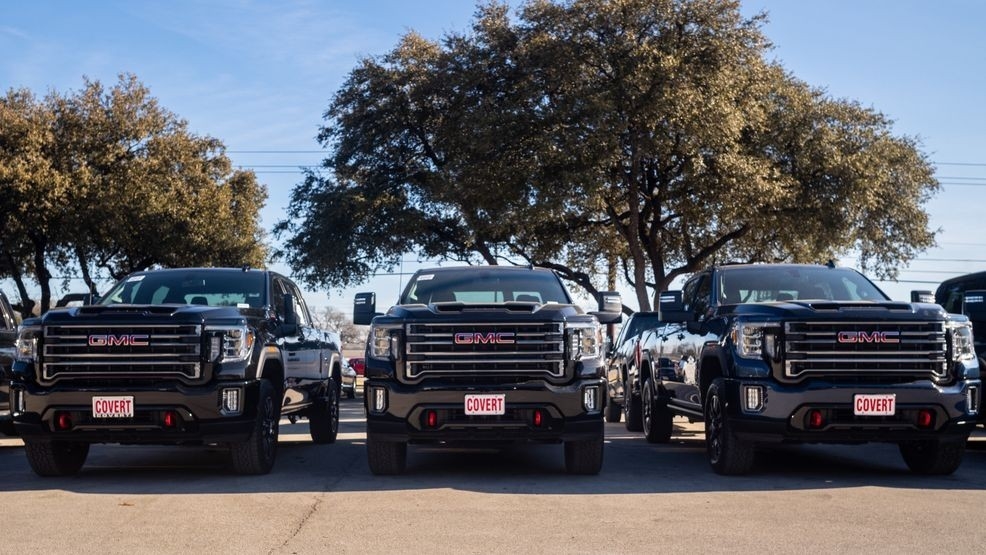Description
(TNND) — Automakers are starting to report the early impacts of President Donald Trump’s tariffs, with General Motors telling investors Tuesday that it took a $1.1 billion hit from tariffs last quarter.
A day earlier, Stellantis, which makes Chrysler, Dodge and Jeep vehicles, told investors that it felt about a $387 million net impact from tariffs in the first half of the year.
Both automakers said they expect tariffs to take an even bigger bite of their profits in the coming months.
“It's starting to show up,” Sean Tucker, lead editor for Kelley Blue Book, said of tariff impacts on automakers.
Trump has announced, altered and paused a slew of tariffs as he looks to bolster domestic manufacturing and negotiate more favorable trade deals.
The Budget Lab at Yale says Americans face an overall average effective tariff rate of 20.6%, the highest since 1910.
KBB reported that tariffs add about $5,700 to the cost of each imported vehicle.
Tucker said automakers operate with complex supply chains “with a billion different dials they can turn to try to keep that impact from hitting the consumer too hard.”
“But it's starting to hit them, Tucker added. “And they can't hide that (from customers) forever."
For example, Tucker said that the Chevrolet Trax comes from South Korea.
That’s about a $20,000 car.
“You can't raise that thing to $25,000,” Tucker said. “The consumer who's looking at a $20,000 car is not going to pay $25,000. But maybe you've got a Chevy Silverado that's built in Illinois that sells at an average of $60,000, and you sell a lot more of those. Can you raise that price slightly to offset the cost of the tariffs to keep importing the Trax?”
GM saw net income fall to about $1.9 billion last quarter, down from $2.9 billion a year earlier.
The automaker noted the impact of tariffs, “reflecting minimal mitigation offsets” so far.
But it said efforts are underway to mitigate at least 30% of tariff impacts “through manufacturing adjustments, targeted cost initiatives, and consistent pricing.”
CEO Mary Barra said in a letter to shareholders that they recently announced $4 billion of new investment in their U.S. assembly plants to add 300,000 units of capacity for light-duty pickups, full-size SUVs and crossovers.
That’s one of the steps GM is taking to reduce its tariff exposure, she said.
Barra said that capacity will begin coming online in 18 months. And GM projects it will build more than 2 million vehicles in the U.S. each year as it scales.
Barra also told investors that GM will grow its electric vehicle fleet, even as she admitted that the EV industry will see slower growth. And changes from Washington have given gas-powered cars “a longer runway.”
Republicans used Trump's massive "One Big Beautiful Bill Act" to roll back green energy subsidies, which included the $7,500 EV tax credit. That now ends this fall, more than seven years sooner than it was previously set to sunset.
SEE ALSO: Expect rush of EV buyers before $7,500 tax credit goes away, KBB expert says
Stellantis said the early effects of tariffs had a significant impact on their first-half results. The company released preliminary first-half financials.
Stellantis made the decision to suspend current-year financial guidance in April due to tariff uncertainties.
And the company said Monday that quarterly shipments in North America dropped 25% compared to last year under the impact of tariffs.
Stellantis CFO Doug Ostermann told reporters the tariff impacts could double in the second half of the year.
Ostermann called tariffs “inherently inflationary.”
“And a lot of us in the industry, I think, have been reluctant to raise price because the tariff policy has been changing so much,” Ostermann said in response to a question during a conference call with analysts. “I think people have been slow to react because we're all kind of waiting to see how it all evolves. And of course, we, most of the (original equipment manufacturers) in North America anyway, typically will run 60 to 90 days of inventory that wasn't subject to tariffs that you could kind of continue to sell down. I think we're coming to the end of that period. I think in the second half you will see more reaction from various OEMs. And I think there will be some mitigation. But we'll have to see how it evolves.”
Ford will release its second-quarter earnings next week.
Every brand is in a unique position, so tariffs impact them all at different dates, KBB’s Tucker said.
Toyota dealers have mostly post-tariff cars on their lots now, he said.
At the other end of the scale, Audi dealers still have plenty of cars imported at pre-tariff prices.
Automakers generally keep about two months’ worth of cars in stock, he said.
KBB found that new-vehicle manufacturer’s suggested retail prices moved higher in June for the third straight month. But the MSRPs have increased more so far than the average transaction prices.
“The price they're paying to import may have gone up, but the ... sticker price that you pay will not go up for several months after that because they're still selling those pre-tariff cars,” Tucker said of the delayed impact on the consumers.
RELATED STORY: Tariff concerns still have American consumers in sour mood: U of Michigan survey
Tucker said there is no such thing as a domestic automaker.
Even American companies have production all over the globe.
And GM, Ford and Stellantis have supply chains integrated throughout the U.S., Canada and Mexico.
Even if final assembly is done at a plant in the U.S., parts come across the border.
“They pass back and forth over the border multiple times sometimes,” Tucker said. “And that's been one of the complications of trying to figure out how these tariffs even impact them. If you build a wiring harness in Ohio and ship it to Mexico, where it's built into a small motor, and then ship that to Illinois, where it's built into a seat, how many times did it get tariffed?”
Tucker said automakers are trying to move jobs back to the U.S.
But that can take time and a lot of money.
He said automakers will amortize the cost of a new factory over 50 years. So, he said, they may be hesitant to act quickly on the policies of a president with three and a half years left on his term.
And Tucker said automakers often plan a decade out, including with contracts, for a design cycle on a make and model that typically lasts five to seven years.
Other Related News
07/23/2025
LOS ANGELES TNND The man accused of intentionally driving through a crowd outside a night...
07/23/2025
COLUMBIA SC WACH Prisma Health officials have confirmed the death of one person in the Mi...
07/23/2025
ECHOLS COUNTY Ga WALB - A Homerville man is wanted after a home invasion and kidnapping th...
07/23/2025
Guido PeluffoTue July 22nd 2025 at 733 PMUpdated Wed July 23rd 2025 at 647 AMFirst lady Me...
07/23/2025












